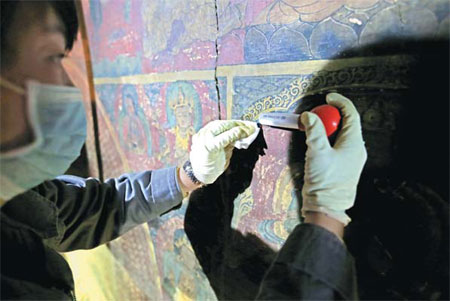
 |
|
A specialist from the Chinese Academy of Cultural Heritage repairs murals at Drepung Monastery in Lhasa, the Tibet autonomous region. |
This work was called off because varnish causes irreversible damage - preventing moisture contained in the paintings from evaporating, which will eventually force open the murals, causing them to fall off the wall.
Zhang Jihong, from the Chinese Academy of Cultural Heritage, said the original pigments, such as ox gelatin, allowed ventilation. The repair team will continue to use these traditional materials, which cause minimal harm because they are water-soluble and can be removed with clean water if anything goes wrong. This way, the murals are likely to last for another 600 years, Zhang said.
Zhang's team follows a tight schedule, with public holidays reduced and extra hours worked on Saturday mornings.
|
 |
 |
"But we don't rush things through. I have a clear plan every day for each team member. A tiny spot can have several kinds of damage, which needs to be dealt with cautiously. If the project proceeds more slowly than expected, the planned deadline can wait. We don't want any mistake, otherwise a piece of invaluable mural may be gone for good," Zhang said.
Alongside the repair work, a group of Tibetan officials will receive training on the conservation of murals and historical heritage in general, deepening their knowledge about archeology, history and religion.
From April to August, the State Administration of Cultural Heritage held training sessions for officials working in museums or fields relating to relic conservation in Tibet.
Zhang said this is a multi-disciplinary subject, encompassing chemistry, material science, history and archeology. Skills and equipment commonly seen in the medical world - for example, the tubes used for intravenous drips - are placed in cracked walls and injected with grouting materials for structure consolidation.
Kelsang Tsering, 57, deputy dean of the school of arts at Tibet University in Lhasa, is a painter who has staged exhibitions in many countries and also conducted field research at monasteries in Tibet on the conditions of ancient murals, finding that leaks caused by rain remain a widespread problem, leading to damage.
He said it is encouraging to see that both the authorities and the public have become more enthusiastic about the protection of cultural relics. People are beginning to understand that ancient murals passed down for centuries are much more valuable than new paintings, he said.
However, large-scale restoration efforts, supported mainly by the central government, have focused on major temples, with many smaller ones awaiting renovation projects. People interested in art and preserving ancient relics can also contribute and make an investment, Kelsang Tsering said.
Mural restoration work in Tibet requires a combination of modern equipment and local knowledge of the painting skills and traditional materials, he added.
Contact the writers at daqiong@chinadaily.com.cn and liyao@chinadaily.com.cn